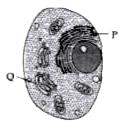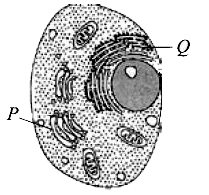Refer to the given dichotomous key and select the incorrect option regarding organisms P, Q, R and S.
I. (a) Animals with cellular level of body organisation. - __P__
(b) Animals with tissue/organ/ organ system level of body organisation. - Go to II
II. (a)Animals possessing bilateral symmetry. - Go to III (a)
(b)Animals possessing radial symmetry.- Go to III (b)
III. (a) True coelom is present. - Go to IV (a)
True coelom is absent. - Go to IV (b)
IV. (a) Notochord is present. __Q__
(b) Notochord is absent. - Go to V
V. (a) It is represented by medusa form. ____R___
(b) It is represented by polyp form. - ___S___
Body of organism P could contain numerous small pores called ostia and a large opening called osculum on top.
Organism Q could possess gill slits at some stage of its life.
The body of organism Scould be differentiated into head, visceral mass and ventral foot.
Organism R could possess nematocysts.
The correct Answer is:C
To solve the problem, we will analyze the given dichotomous key step by step to identify the organisms P, Q, R, and S, and then determine which of the provided statements is incorrect.
1. Identify Organism P:
- The key starts with animals having a cellular level of body organization. This refers to Porifera (sponges), which have a porous body structure with numerous small openings (ostea) and a large opening (osculum).
- Conclusion: Organism P is Porifera.
2. Identify Organism Q:
- The next step involves animals with tissue/organ/organ system level of body organization. We move to the next part of the key.
- Organism Q is determined by the presence of bilateral symmetry, which is characteristic of many animals, including Chordates.
- Conclusion: Organism Q is likely a Chordate.
3. Identify Organism R:
- In the next step, we check for true coelom presence. If true coelom is present, we proceed to check for the presence of a notochord.
- Organism R is identified as possessing a notochord and could be a Cnidarian (like jellyfish), which can be represented in the medusa form.
- Conclusion: Organism R is represented by the medusa form.
4. Identify Organism S:
- The last part of the key indicates that if the organism is represented by the polyp form, it is also a Cnidarian.
- Conclusion: Organism S is represented by the polyp form.
Analyzing the Options:
Now, we will analyze the statements regarding organisms P, Q, R, and S to find the incorrect one.
1. Statement about Organism P:
- "Body of organism P could contain numerous small pores called as the ostea and a large opening called as the osculum at the top."
- This statement is correct as it describes Porifera accurately.
2. Statement about Organism Q:
- "Organism Q could possess gill slit at some stages of their life."
- This statement is correct as many chordates exhibit gill slits during embryonic development.
3. Statement about Organism S:
- "The body of the organism S could differentiate head, visceral mass, and ventral foot."
- This statement is incorrect because it describes characteristics of Mollusca, while S is identified as a Cnidarian (polyp form).
4. Statement about Organism R:
- "Organism R could possess nematocytes."
- This statement is correct as nematocytes are stinging cells found in Cnidarians.
Conclusion:
The incorrect option regarding organisms P, Q, R, and S is the statement about organism S.
- The key starts with animals having a cellular level of body organization. This refers to Porifera (sponges), which have a porous body structure with numerous small openings (ostea) and a large opening (osculum).
- Conclusion: Organism P is Porifera.
- The next step involves animals with tissue/organ/organ system level of body organization. We move to the next part of the key.
- Organism Q is determined by the presence of bilateral symmetry, which is characteristic of many animals, including Chordates.
- Conclusion: Organism Q is likely a Chordate.
- In the next step, we check for true coelom presence. If true coelom is present, we proceed to check for the presence of a notochord.
- Organism R is identified as possessing a notochord and could be a Cnidarian (like jellyfish), which can be represented in the medusa form.
- Conclusion: Organism R is represented by the medusa form.
- The last part of the key indicates that if the organism is represented by the polyp form, it is also a Cnidarian.
- Conclusion: Organism S is represented by the polyp form.
Now, we will analyze the statements regarding organisms P, Q, R, and S to find the incorrect one.
- "Body of organism P could contain numerous small pores called as the ostea and a large opening called as the osculum at the top."
- This statement is correct as it describes Porifera accurately.
- "Organism Q could possess gill slit at some stages of their life."
- This statement is correct as many chordates exhibit gill slits during embryonic development.
- "The body of the organism S could differentiate head, visceral mass, and ventral foot."
- This statement is incorrect because it describes characteristics of Mollusca, while S is identified as a Cnidarian (polyp form).
- "Organism R could possess nematocytes."
- This statement is correct as nematocytes are stinging cells found in Cnidarians.
The incorrect option regarding organisms P, Q, R, and S is the statement about organism S.
Topper's Solved these Questions
Similar Questions
Knowledge Check
Cellular level of body organisation is found in
AMoneraBProtistaCFungiDBoth A and BOrgan system level of organisation is observed in
AChordatesBAnnelidsCMolluscaDAll of theseRefer to the given diagram of an animal cell and select the correct option regarding P and Q
 ASome of the vesicles of P store digestive enzymes obtained Q from Q in inactive state to form primary lysosomeBPolypeptides synthesised at Qare transported to P where they are modified into functional proteins for secretionCQ synthesises acrosome which plays an important role in the fertilisation process in humansDP is absent in pancreatic cells and cells of salivary glands whereas Q is absent in liver cells.
ASome of the vesicles of P store digestive enzymes obtained Q from Q in inactive state to form primary lysosomeBPolypeptides synthesised at Qare transported to P where they are modified into functional proteins for secretionCQ synthesises acrosome which plays an important role in the fertilisation process in humansDP is absent in pancreatic cells and cells of salivary glands whereas Q is absent in liver cells.
Tissue level body organisation occurs in
View SolutionAn aclomate animals with bilateral symmetry is
View SolutionAn acoelomate animal with bilateral symmetry is
View SolutionAn acoelomate animal with bilateral symmetry is
View SolutionWhich of the following animals' body shows bilateral symmetry ?
View Solution

